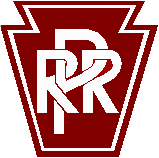Pennsylvania Railroad
Pittsburgh Cincinnati Chicago & St. Louis
Railroad (The Pan Handle)
Columbus & Xenia Railroad (1850)
Columbus Piqua & Indiana Railroad (1853)
Steubenville & Indiana Railroad (1864)
Cleveland Akron & Columbus Railroad
(CA&C)
Cleveland Mt. Vernon & Columbus Railroad (1873)
Sandusky Branch
Sandusky & Columbus Short Line (1893)
Compared to the four
other Columbus class I railroads the Pennsylvania Railroad was the big enchilada.
It had more routes into and out of Columbus (five), it had more yards (at
least seven), more passenger and mail trains (46 in 1951), a dining car
commissary, the biggest shops
(Spruce Street and St. Clair Avenue/20th Street) and the most
employees. At one time the PRR was the largest employer in Columbus
with 8000 workers just after World War I, 4500 after World War II and 3300
in 1951 working at the 20th Street shops. The 20th Street shops were the largest PRR shops west of Altoona, Pa. Steam
locomotives could receive all five classified maintenance routines at 20th Street or the
men could even build a
new locomotive.
The portion of the Pennsylvania Railroad through Columbus,
that would become know as "The Pan handle",
connected Pittsburgh, Cincinnati, Chicago and St. Louis. The Pan
Handle
was a collection of many smaller lines that starting in 1869 were leased and
consolidated until in 1916 The Pittsburgh,
Cincinnati, Chicago & St. Louis Railroad Company (PCC&St.L)
was created and leased to the PRR as had the previous holding companies
starting from 1869. The name was
a handy
way to differentiate the PCC&St.L portion of the PRR from the route that ran
from Pittsburgh to Chicago across northern Ohio that carried the premier PRR
passenger train the Broadway limited. The Pan Handle came into
Columbus from Pittsburgh on a shared PRR/B&O route between Newark and
Columbus. It entered from the east along what is now the
southside of Port Columbus, past the Defense Supply Center, crossing Alum
Creek and Nelson Road. South of Fifth Avenue, it went north of the old Fort
Hayes where it then swung southwestward to enter Columbus Union Station on
North High Street.
Along this route,
on the east side of Columbus, were the 20th Street shops, yards A and B, and
the St. Clair Avenue roundhouse as well as livestock pens, icing facilities
and servicing facilities for the steam locomotives. In 2007 all but a
few railroad tracks, operated by the Ohio Central Railroad are left, with much of the
Pan Handle land on the east
side of Columbus now used by the I-670
right-of-way.
From the west
there were two Pan Handle routes, the "Little Miami" and the "Piqua Line" The
Little Miami line was the first railroad to enter Columbus in 1850. Then
it was called the Columbus and Xenia Railroad. At Xenia it connected
with the original Little Miami Railroad that ran from Xenia to Cincinnati. Later a route
would be built from Xenia to Dayton and on to Richmond, IN;
Indianapolis and St. Louis. The Little Miami entered Columbus
from the west in the area north of and parallel to Broad Street,
crossed the Scioto river in front of the old Ohio Penitentiary and on into Columbus
Union Station.
The Piqua Line
connected Columbus with Bradford, OH; Logansport, IN and Chicago. At Bradford
there was a junction with one leg going to New Paris, OH (just east of Richmond, IN) were it
joined with the
line from Xenia also giving the Piqua line access to Indianapolis and St. Louis.
Some passenger and mail trains heading to St. Louis from Columbus would take the Little
Miami, others the Piqua line. The Piqua Line also entered Columbus
from the west going through Marble Cliff, the southern edge of Grandview
Heights, it crossed the Olentangy River, went south of Goodale Street, crossed Dennison Avenue,
it went north of the Ohio Penitentiary and
finally entered
Columbus Union Station. Along this route was Grandview Yard and
the Spruce Street roundhouse used for passenger locomotives. Spruce
Street also included a coach and Pullman car yard as well as the dining car
commissary.
Two other PRR
lines out of Columbus were the Cleveland, Akron and Columbus Railroad (CA&C)
and the Sandusky Branch.
These two were not included under the Pan Handle name,
The CA&C joined with other lines to become the
Pennsylvania Ohio & Detroit Railroad in 1925, which was immediately leased to the PRR.
The CA&C entered Columbus from the northeast through Westerville, ran parallel to
Cleveland Avenue to a point north of Fort Hayes where it swung
southwestward to parallel the PRR/B&O into Columbus Union Station.
The
Sandusky Branch was a big coal hauler, in the 1950's, taking coal from both the N&W and
the C&O to the Lake Erie Coal Docks at Sandusky, OH. Built
as the Sandusky & Columbus Short Line in 1893 it was purchased by the PRR
in 1902. Up until 1930 the Sandusky Branch had meager passenger
service. The line came
into Columbus from the north through Delaware, the east side of Worthington,
along the west side of the Ohio State Fair Grounds and terminated in Grogan
Yard just north of the Fair Grounds.
What made Columbus exciting
for the railfan in the 1950's was the heavy use of steam engines on Pennsy freight trains (as well as
steam on three of the other class I railroads).
Columbus and specifically the Sandusky Branch became one of the last of
the PRR lines to be dieselized. Here you could see J1's, I1's, H10's,
and even in 1956, 2-10-4 oil burners leased from the Santa Fe Railroad.
If you lived in Columbus, in the 1950's, you could easily forget that the end of steam was
coming. From this page you will be able to view scenes from those
1950's.



